Soil/Landform Unit 65
Landform Unit Description
Page top
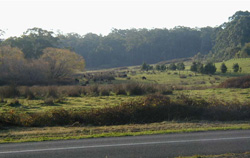 Open forests of the landscape evident abutting cleared land on lower slopes |
0.24% of CMA region North of the Gellibrand River, Cretaceous sandstones and mudstones outcrop in the valleys of Yahoo Creek, Gum Gully Creek and an unnamed creek to the west of Black Bridge Road. These sediments belong to the Moonlight Head Beds of the Otway Group. Slopes are steep and valleys are narrow, in sharp contrast to the rounded hills of adjacent Paleogene sediments. The soils are similar to those found on other outcrops of Cretaceous sediments in the Otway Range, with the exception that surface horizons contain appreciably more sand and the parent material is usually highly weathered. Open forests of Eucalyptus obliqua, E. ovata and E. aromaphloia are similar to those found on the drier slopes of soil-landform unit 63. Most parts of these valleys remain virtually uncleared and quite remote. Hardwood forestry is the main land use, although the rugged terrain makes access difficult. Some softwood plantations have been established in the catchment of Yahoo Creek. Landslips occur on these soils under native forest, and the incidence increases dramatically following clearing. Sheet erosion and gully erosion are also prone to occur. | 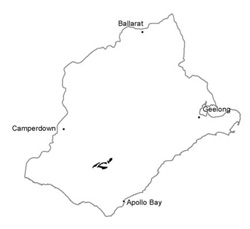 |
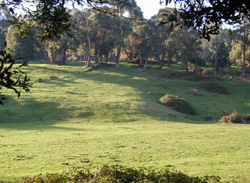 Cleared gentle lower slopes and swale | 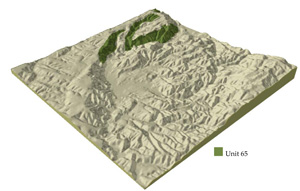 |
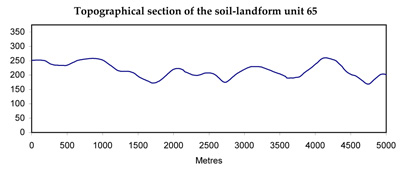 | 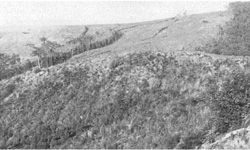 Steep and rugged hills surrounding Yahoo Creek are difficult to manage due to rapid regrowth of vegetation |
Component | 1 | 2 | 3 | 4 |
Proportion of soil-landform unit | 35% | 45% | 15% | 5% |
| CLIMATE Rainfall (mm) | Annual: 850-1000, lowest January (40), highest August (130) | |||
| Temperature (oC) | Annual: 12, lowest July (7), highest February (18) | |||
| Seasonal growth limitations | Tempreature: less than 10oC (av.) June-September Precipitation: less than potential evapotranspiration November-March | |||
| GEOLOGY Age and lithology | Cretaceous highly feldspathic fluvio-volcanic sandstone and mudstone (Moonlight Head Beds); minor Paleogene marine glauconitic sand | |||
| Geomorphology | ||||
| LANDUSE | Uncleared areas: Hardwood forestry for sawlogs, poles and posts; nature conservation; water supply Minor cleared areas: Sheep and cattle grazing; water supply | |||
| TOPOGRAPHY Landscape | Deeply dissected hills to the north of Gellibrand River | |||
| Elevation range (m) | 60-270 | |||
| Local relief (m) | 110 | |||
| Drainage pattern | Dendritic with small radial areas | |||
| Drainage density (km/km2) | 2.4 | |||
| Landform | Hills | |||
| Landform element | Steep slope | Crest and upper slope | Slope | Swale and gentle lower slope |
| Slope and range (%) | 50 (20-70) | 15 (2-30) | 35 (15-45) | 13 (1-25) |
| Slope shape | Linear | Linear | Linear | Concave |
| NATIVE VEGETATION Structure | Open forest | Open forest | Open forest | Open forest |
| Dominant species | E. ovata, E. obliqua, E. radiata, E. aromaphloia, E. viminalis | E. obliqua, E. ovata, E. aromapholia, E. radiata | E. viminalis, E. obliqua | E. viminalis, E. obliqua, Acacia melanoxylong |
| SOIL Parent material | In situ weathered sandstone and mudstone, colluvial rock | In situ deeply weathered sandstone and mudstone | In situ weathered sandstone and mudstone | Colluvium |
| Description (Corangamite Soil Group) | Stony brown gradational soils (7) | Yellow-brown gradational soils, coarse structure (7) | Brown gradational soils (7) | Dark brown gradational soils (7) |
| Soil type sites | OTR732 | OTR750 | OTR428, OTR736 | |
| Surface texture | Fine sandy loam | Sandy clay loam | Loam | Loam |
| Permeability | High | Low | Moderate | Moderate |
| Depth (m) | 0.7 | 1.2 | 0.9 | >2 |
| LAND CHARACTERISTICS, POTENTIAL AND LIMITATIONS | Stony shallow soils with weak structure and low water holding capacity on steep slopes are prone to sheet erosion and landslides. | Soils of low permeability on the steeper slopes are prone to sheet and rill erosion. Dispersible subsoils are prone to gully erosion. | Clay subsoils on steep slopes subject to periodic saturation are prone to landslips. Steep slopes are prone to sheet erosion. | Weakly structured soils receiving runoff from adjacent hills are prone to scour gullying siltation and flooding. |


